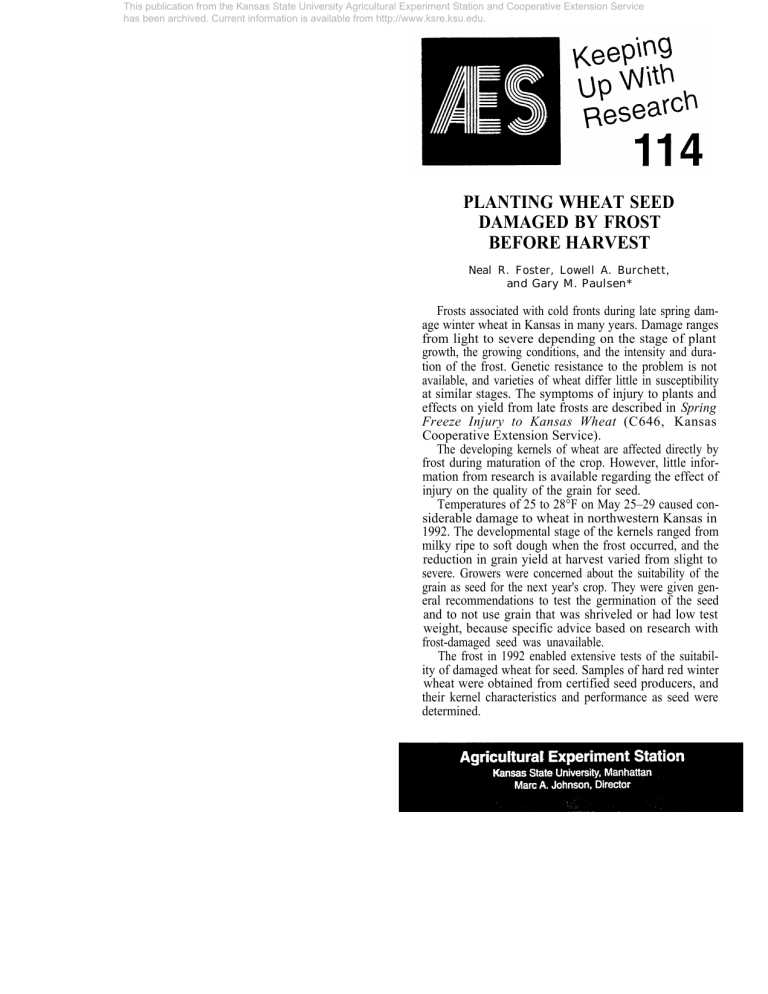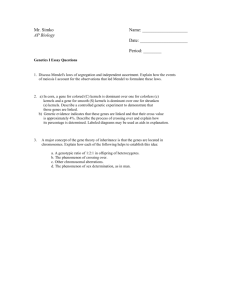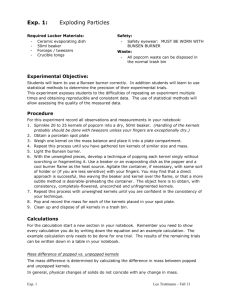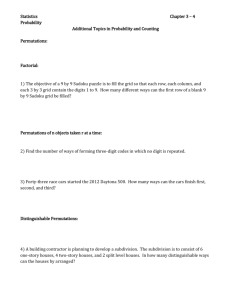Document 13273634

This publication from the Kansas State University Agricultural Experiment Station and Cooperative Extension Service has been archived. Current information is available from http://www.ksre.ksu.edu.
PLANTING WHEAT SEED
DAMAGED BY FROST
BEFORE HARVEST
Neal R. Foster, Lowell A. Burchett, and Gary M. Paulsen*
Frosts associated with cold fronts during late spring damage winter wheat in Kansas in many years. Damage ranges from light to severe depending on the stage of plant growth, the growing conditions, and the intensity and duration of the frost. Genetic resistance to the problem is not available, and varieties of wheat differ little in susceptibility at similar stages. The symptoms of injury to plants and effects on yield from late frosts are described in Spring
Freeze Injury to Kansas Wheat (C646, Kansas
Cooperative Extension Service).
The developing kernels of wheat are affected directly by frost during maturation of the crop. However, little information from research is available regarding the effect of injury on the quality of the grain for seed.
Temperatures of 25 to 28°F on May 25–29 caused considerable damage to wheat in northwestern Kansas in
1992. The developmental stage of the kernels ranged from milky ripe to soft dough when the frost occurred, and the reduction in grain yield at harvest varied from slight to severe. Growers were concerned about the suitability of the grain as seed for the next year's crop. They were given general recommendations to test the germination of the seed and to not use grain that was shriveled or had low test weight, because specific advice based on research with frost-damaged seed was unavailable.
The frost in 1992 enabled extensive tests of the suitability of damaged wheat for seed. Samples of hard red winter wheat were obtained from certified seed producers, and their kernel characteristics and performance as seed were determined.
This publication from the Kansas State University Agricultural Experiment Station and Cooperative Extension Service has been archived. Current information is available from http://www.ksre.ksu.edu.
Procedures Results
The variety TAM 107 was used because it is the most widely grown in northwestern Kansas. Eleven
Test weight of the wheat decreased steadily as the level of frost damage increased (Table 1). The nondamaged seedlot had a high percentage of large kernels and seedlots were evaluated, and results are presented for four lots that represent a range of injury. A sound seedlot of TAM 107 from the area was the control.
Test weights of the uncleaned seedlots containing
12% moisture were measured by Federal Grain
Inspection Service methods. All seedlots, particularly those that were damaged most, contained a large range few small kernels, whereas the severely damaged seedlot had fewer large kernels and more small kernels. The kernel weights of all size fractions fell as the severity of injury increased.
Germination of large kernels was high after harvest, of kernel sizes. The distribution of sizes was determined by sieving the kernels with 6/64 x 3/4-inch and 5/64 x 3/4-inch slotted screens and calculating the percentages by after storage, and after accelerated aging, regardless of the level of frost injury (Table 2). Medium kernels also germinated well after no or slight injury, but viability weight above and below the screens. One thousand kernels in each fraction were weighed to determine their average weight.
dropped after moderate or severe injury. Frost was most damaging to small kernels, which germinated poorly in all tests after moderate or severe injury.
Germination of 100 kernels in each of the three size fractions of all seedlots was measured after they were prechilled at 41°F for 5 days and incubated on moistened, heavy paper at 59°F for 7 days. After 15 months of storage at room temperature, germination was measured again without the prechilling treatment. Samples of the seedlots also were subjected to accelerated aging at 104°F for 72 hours, prechilled, and tested for
Seedling emergence from different planting depths followed the same pattern as germination (Table 3).
Emergence was high from all planting depths for large seeds after all levels of injury. Moderate or severe injury decreased emergence at all planting depths for medium kernels. Emergence was always poorer from small kernels than from large or medium kernels, particularly at the greater levels of frost injury.
germination.
Ability of the seedlots to form a stand of wheat was estimated by planting the seeds in a greenhouse at different depths. Twenty-five seeds in each size fraction of all seedlots were planted 1, 2, 3, or 4 inches deep in masonry sand, which was moistened as needed, and emerged seedlings were counted twice weekly.
All experiments were in randomized complete block designs with four replications of treatments. Data were analyzed statistically by the general linear model method.
Discussion
Frost damage was obviously selective, affecting some kernels and leaving others in sound condition. This selectivity. which probably was associated with differences in maturity among tillers or among kernels on the same spike. has important implications for the use of frost-damaged wheat for seed.
Deficiencies in test weight, germination, and emergence were caused by the increased content of small kernels in frost-damaged seedlots. Moderate or severe
Table 1. Test weight before sieving and percentage distribution and kernel weight after sieving of seedlots of
TAM 107 wheat with different levels of frost injury.
Level of injury
Test weight lbs/bu
None 62
59 Slight
Moderate 55
Severe 52
LSD (0.05) 1
Above
6/64 x 3/4 in
(large)
60
54
54
46
7
Above
5/16 x 3/4 in
(medium)
%
26
34
21
22
3
Below
5/16 x 3/4 in
(small)
14
12
25
32
6
Large
42
35
35
34
1
Kernel weight
Medium mg/kernel
27
24
20
20
1
Small
17
16
12
12
2
This publication from the Kansas State University Agricultural Experiment Station and Cooperative Extension Service has been archived. Current information is available from http://www.ksre.ksu.edu.
Table 2. Germination percentage of large, medium, and small, frost-damaged kernels of TAM 107 wheat after harvest, after 15 months of storage, and after accelerated aging.
Time of testing and level of injury
Large kernels
Germination
Medium kernels
Small kernels
After harvest:
None
Slight
Moderate
Severe
LSD (0.05)
98
99
95
98
2
98
97
57
76
7
83
75
18
19
9
After storage:
None
Slight
Moderate
Severe
LSD (0.05)
97
99
93
88
2
After accelerated aging:
None
Slight
Moderate
Severe
LSD (0.05)
95
99
92
96
7
97
87
43
63
3
91
94
64
62
9
85
79
12
11
4
76
76
8
11
7 injury lowered the test weight below the minimum of
56 lbs/bu and, as calculated from the percentage composition of the original seedlots, decreased the germination below the minimum of 85% recommended for w h e a t s e e d b y t h e K a n s a s C r o p I m p r o v e m e n t
Association. However, the performance of large kernels was excellent, regardless of the degree of frost injury. Because of the selective injury, the seedlots could be conditioned to remove the small, damaged kernels and leave the large, sound kernels. Nearly one-half or more by weight of the most severely damaged seedlots consisted of large kernels that could be used for seed.
Increasing the seeding rate of frost-damaged seed could compensate for the small kernels but might not be practicable. Other research suggests that plants from small seeds yield less than those from large seeds. The ability of small seeds to produce a stand, particularly
This publication from the Kansas State University Agricultural Experiment Station and Cooperative Extension Service has been archived. Current information is available from http://www.ksre.ksu.edu.
Table 3. Emergence percentage of seedlings from large, medium, and small, frost-damaged kernels of TAM 107 wheat planted at four depths in sand.
Planting depth and level of injury
Large kernels
Emergence
Medium kernels
Small kernels
1 inch:
None
Slight
Moderate
Severe
LSD (0.05)
95
97
94
96
5
94
95
58
68
12
83
79
23
23
8
2 inches:
None
Slight
Moderate
Severe
LSD (0.05)
3 inches:
None
Slight
Moderate
Severe
LSD (0.05)
4 inches:
None
Slight
Moderate
Severe
LSD (0.05)
94
93
94
97
5
95
97
90
98
2
97
93
86
95
3
92
93
54
64
10
91
98
50
58
6
92
94
44
59
6
77
72
16
14
9
78
62
8
10
7
69
.58
4
10
6
This publication from the Kansas State University Agricultural Experiment Station and Cooperative Extension Service has been archived. Current information is available from http://www.ksre.ksu.edu.
under adverse conditions such as deep planting, also might be questionable.
The high level of viability after natural and accelerated aging suggested that large kernels can be stored safely under proper conditions for 15 months. Most of the loss in germination of medium and small kernels occurred before harvest, but they still survived storage less well than large kernels.
Conclusions
1.
Frost damage during maturation of wheat is selec-
2.
tive. injuring some kernels and leaving others unchanged.
Small, damaged kernels lower the quality of the grain for seed but can by removed by sizing with appropriate sieves.
3.
Large kernels from seedlots that are damaged by frost have high germination, excellent seedling emergence, and good storability.
*Former graduate student (now State Seed Laboratory, Montana State University, Bozeman, MT); Crop
Scientist. Kansas Crop Improvement Association,
2000 Kimball Avenue, Manhattan, KS; and Professor,
Department of Agronomy, respectively.
Contribution no. 97–1 76–5 from the Kansas
Agricultural Experiment Station.
Kansas State University Agricultural Experiment
Station and Cooperative Extension Service,
Manhattan, Kansas 66506
SRL 114 January 1997
Kansas State University IS committed to a policy of nondiscrimination on the basis of race, sex, national origin disability, religion, age, sexual orientation, or other nonmerit reasons, in admissions, educational programs or activities, and employment (including employment of disabled veterans and veterans of the Vietnam Era), all as required by applicable laws and regulations. Responsibility for coordination of compliance efforts and receipt of inquiries, Including those concerning Title IX of the Education Amendments of
1972, Section 504 of the Rehabilitation Act of 1973, and the Americans with Disabilities
Act, has been delegated to Jane D Rowlett, Ph. D., Director of Unclassified Affairs and
University Compliance, Kansas State University, 111 Anderson Hall, Manhattan, KS
66506-0124 (913-532-4392)






